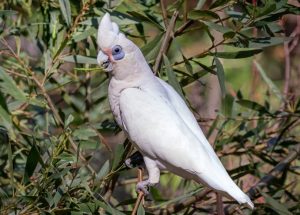Bare-eyed Cockatoos, scientifically known as Cacatua sanguinea, are captivating birds known for their playful demeanor and distinct appearance. Understanding the natural habitat and living conditions of these magnificent creatures is essential for those interested in providing them with optimal care. Below your

1. Origin and Natural Habitat: Bare-eyed Cockatoos are native to Australia, primarily found in the northern and eastern regions of the country. Their natural habitat encompasses a diverse range of environments, including woodlands, savannas, and open forests. These cockatoos have adapted to both coastal and inland regions, showcasing their versatility in various landscapes.
2. Preferred Living Environments: In the wild, Bare-eyed Cockatoos thrive in areas with access to water sources, such as rivers or lakes. They are social birds that often congregate in flocks, displaying a strong sense of community. The open woodlands and eucalyptus-dominated landscapes provide them with ample opportunities for foraging and social interactions.
3. Behavioral Characteristics: Bare-eyed Cockatoos are known for their active and playful behavior. They are skilled flyers, utilizing their strong wings to navigate through their natural surroundings. Their playful antics, including hanging upside down and engaging in vocalizations, reflect their high intelligence and sociable nature.
4. Dietary Preferences: In the wild, these cockatoos have a varied diet that includes seeds, fruits, nuts, and vegetation. Their foraging behavior involves using their powerful beaks to extract seeds from cones or crack open nuts. In a captive setting, replicating this diverse diet is crucial for their overall well-being.
5. Nesting and Breeding: Bare-eyed Cockatoos are cavity nesters, often utilizing tree hollows for nesting purposes. Understanding their natural nesting behavior is essential for creating suitable breeding conditions in captivity. Providing appropriate nesting materials and ensuring a secure environment contributes to their successful reproduction.
6. Adaptation to Human Interaction: These cockatoos are known for their adaptability to human interaction. In their natural habitat, they may encounter human presence, especially in areas with urban development. This adaptability makes them well-suited to captive environments, where they can form strong bonds with their human caretakers.
7. Conservation Status: While Bare-eyed Cockatoos are not currently listed as endangered, habitat loss and potential threats from human activities impact their populations. Understanding their natural habitat and behavior is crucial for conservation efforts aimed at preserving their existence in the wild.
In conclusion, delving into the world of Bare-eyed Cockatoos involves appreciating their native Australian habitat, recognizing their social nature, and providing them with a captive environment that mirrors their natural behaviors. Whether in the wild or as cherished companions, these cockatoos continue to captivate bird enthusiasts with their intelligence and engaging personalities. Reading this article in sure we must have answered the question many have been asking about Where Do Bare Eyed Cockatoo live?
